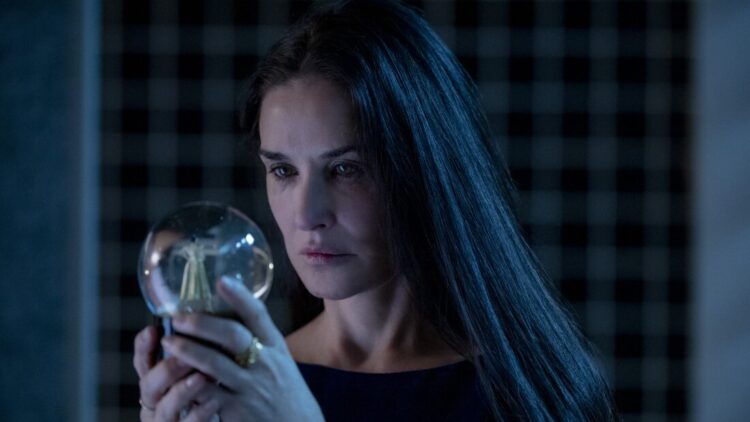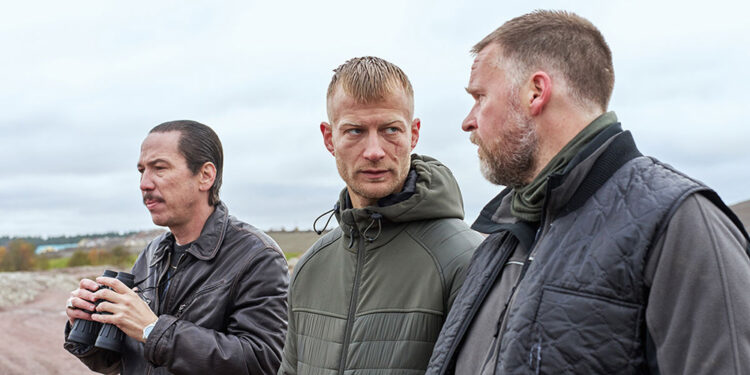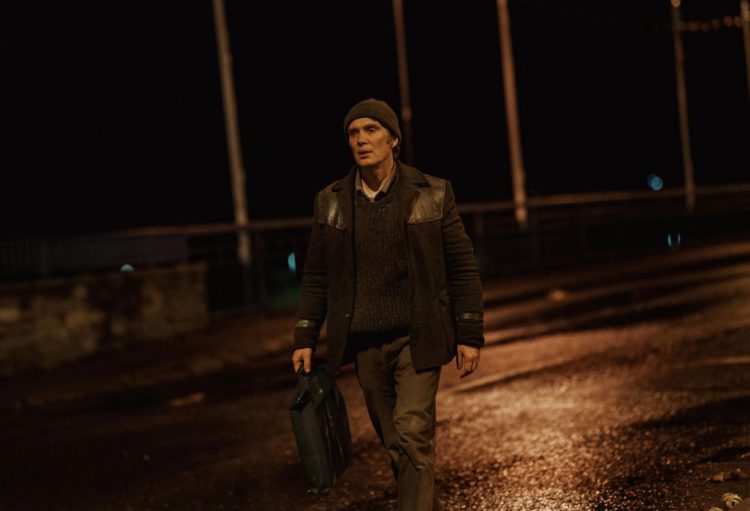

Coralie Fargeat’s Revenge (2017) thrilled audiences with its never-ending finale chase sequence through hallways lubricated in Shining-level quantities of blood. The French filmmaker’s follow-up, The Substance, amps up the gore, adding a strong dose of Cronenbergian body horror. Elisabeth Sparkle (Demi Moore) is a star, a big enough one to merit her own on the Hollywood Walk of Fame, in fact. But when we meet her, she’s on the back nine of her career. Through mouthfuls of prawns—never pausing to close his mouth or swallow––Hollywood executive Harvey (Dennis Quaid, having fun) fires Sparkle from her gig as the host of a popular aerobics TV program. Harvey’s matter-of-fact explanation surrounding Sparkle’s age being the liability in this business, could be perceived as refreshingly honest if it wasn’t so openly sexist and retrograde.
Out of options, she tries a mysterious new treatment called “The Substance.” Injecting himself with a liquid that is presciently “Brat” green, she immediately births a fully formed younger version of herself: this is Sue (Margaret Qualley). While not feral, Sue represents youth as existing in a near-constant emotive, volatile state. She’s more prone to aggravated screams than dialogue. Sue also represents what Hollywood (and Harvey) values above all else: beauty matched with youth. So it’s no surprise when Sue promptly replaces Sparkle as the new face of TV aerobics, beginning a rapid ascent to stardom. This rise threatens the delicate balance of The Substance’s (the product) strict rules, requiring the pair trade off week to week––with one out in the world and the other stowed behind a false bathroom wall, withering away like Dorian Gray’s portrait.
Full of extreme widescreen closeups matched with deliberate sound design, The Substance showcases Fargeat’s firm command of how cinematic language can tell a story visually. The extended finale is somehow even more over-the-top and gory than the memorable one Fargeat gave us in Revenge. At this rate, God help us for what lay in store for her third feature.
I spoke with Fargeat over Zoom about her nontraditional approach to screenwriting and how building out a knowingly-unrealistic world aids the film’s satirical elements and the characters.
The Film Stage: The images matched with the editing style is so cohesive and striking. Was this in there from the beginning, at the script level, or did you develop it later?
Coralie Fargeat: It comes in from the very beginning. Because there is not much dialogue in my films, everything relies on visuals and sound––and performance, of course––so finding these elements is very much a part of the writing process. Basically I write what I’m going to film and how I’m going to edit it. Everything is based on the rhythm of each scene, which has to be at the right level to lead into the next one for the coherence of the universe to work. That’s why I take a lot of time to write and research visuals and sound from the very beginning. These elements build my scripts out as much as the characters and the dialogue.

Coralie Fargeat and Demi Moore at Cannes Film Festival
That’s not the conventional way to write. Did you ever experience pushback on your writing style?
I didn’t go to film school, so I didn’t learn rules to follow. But I watched so many films and I wrote a lot of scripts––that’s how I intuitively learned the basics. I had my own writing style, which was totally not by the book, following no rules at all. But most importantly, it works. No one in the industry ever told me, “Oh, you shouldn’t do it like that.” Because when you read something and you feel something, that’s what’s important. This is what you must trust the most. I did a one-year screenwriter lab before my first feature; it feeds you with guidelines that can be helpful, but they should never be used as a jail that you’re not allowed to open.
My scripts are very detailed and long because I write everything––they’re almost like novels. It gives people who read it the feeling of what the movie is going to be. Picturing the movie––that’s what’s important.
I’m sure that’s a useful bible for the cinematographer, production designer, etc. but what’s your process with actors? How did you work with Demi Moore and Margaret Qualley to craft their performances, since––as you said––they don’t have a lot of dialogue?
We had a lot of conversations in prep with the script, because they must understand the rest of the universe that they are going to interact within. When you work with symbolism, every visual and sound element is part of the character: the yellow coat, the apartment, the set design––it all says something about the character. The fact that the setting is also timeless––that it’s a mix of present, past, future––builds an experience that is not totally grounded into reality. The actors have to enter the universe of the film with its specificities, with the fact that the imagery, the filmmaking, the sound is going to have an important place in building their performance.
So I spent a lot of time showing them visual research, designs, explaining the rhythm of the scenes and how the sound is going to interfere in the filmmaking. This is all part of the rehearsals and the script-readings. It’s about the emotional core of the character and the performance, but also equally about the symbolic part of the performance. My characters don’t have backstories; they exist with what you see from them in the film in a very symbolic way.
Paul Verhoeven’s RoboCop was big for you growing up. How do you feel about satire and The Substance’s lack of subtext in just saying outright: “this is what I’m satirizing and it’s going to be obvious in a fun way”?
Genre films have two lanes: one is the horror, violent, or action element, and the other is humor. Both allow the audience to enter a world that can be very extreme, very violent, and say striking things, but with the possibility to receive it in a way that is not assaulting. They have the relief of laughing, to distance themselves and enjoy the experience. When I grew up, I was sensitive to everything satirical, whether it is Chaplin’s The Great Dictator or the books that I read.
Humor is such a strong weapon. It allows you to be irreverent. It allows you to not follow the rules and to show the absurdity of what rules the world: the violence of domination, the violence of politics. All of this is so violent, and to be able to criticize this in a humorous way is something I have reacted to very strongly since I was a kid. So I welcome that when it comes in my writing, and it comes naturally because that’s what shaped my taste and the way I naturally feel at ease to to express myself.
You’re from Paris. As an outsider, how did you approach satirizing an American place, an American industry? Of course, Hollywood expands beyond just its status as a physical location.
For me, it was the perfect symbol I could find to represent the whole world. I was thinking, “OK, what would be the heightened symbolism of the promise that if you’re beautiful, young, and sexy, you’re going to be loved and you’re going to be the center of attention?” It’s this mythological imagery of Hollywood, of the cinema dream, of the limelight. This dreamy promise that this is going to bring you love and happiness. Everyone has this in their mind, even those who have never been to Hollywood, because Hollywood exists as an unconscious, collective dream that is an idea and not a reality.
Of course it’s also a place that exists for real. But this was not the one I was interested in talking about. I was interested in talking about the symbol and how this symbol can affect those everywhere. That’s why through the visuals, I craft a world that isn’t realistic. This Hollywood is a representation of how we see value, beauty standards––all the injunctions that we have upon us to conform to some kind of ideal. It was a way to represent what I think every woman, everywhere has to go through. It’s my vision of the Hollywood I have in my mind, which is not reality. It’s the one I grew up with, even before I went for real in L.A. and discovered the real Walk of Fame.
That lack of realism is powerful. For instance, that billboard outside of Elisabeth Sparkle’s house––a billboard wouldn’t face houses in the hills. It doesn’t make any sense, except that within the imagery of the movie it absolutely does. I think sometimes films get too tied up making sure everything is tight and fits together perfectly in a logical manner. Sometimes the imagery of this being here is what’s important.
That’s the most important thing for me, and what I trust the most: why the images came the way they came, even if they don’t make sense from a realistic point of view. During the shooting and prep this is what the crew must understand the most. Of course, their first reflex is “Oh, no, it can’t be like that, because it’s not possible.” I say, “But we don’t care that it’s not possible, because this is not reality.” It’s The Substance‘s reality. So little by little, I made everyone understand that what matters is not the realism, but what makes sense for the world of the film. And the world of the film has its own rules, its own codes that pave the way for the audience to be able to go into that craziness. Every detail makes sense to set the rules that this is not reality. An audience can feel at ease to go on this journey because, unconsciously, they have been prepared with every set, with every detail, that it’s some kind of other dimension they can dive into.
The Substance is now in theaters.
The post The Substance Director Coralie Fargeat on Playing By Her Own Rules and the Strong Weapon of Humor first appeared on The Film Stage.



